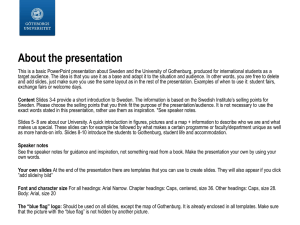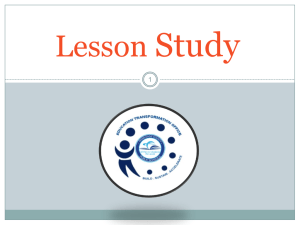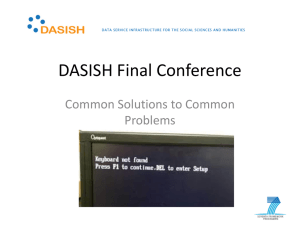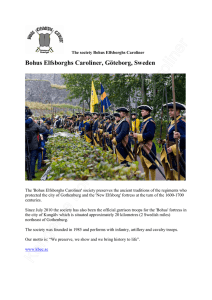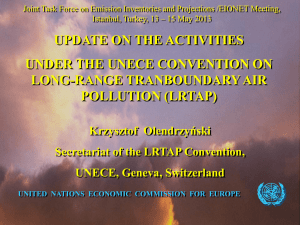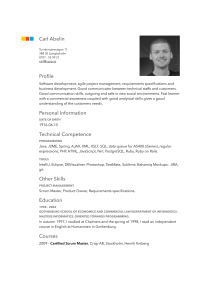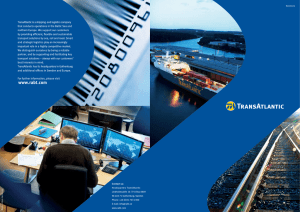final local action plan
advertisement
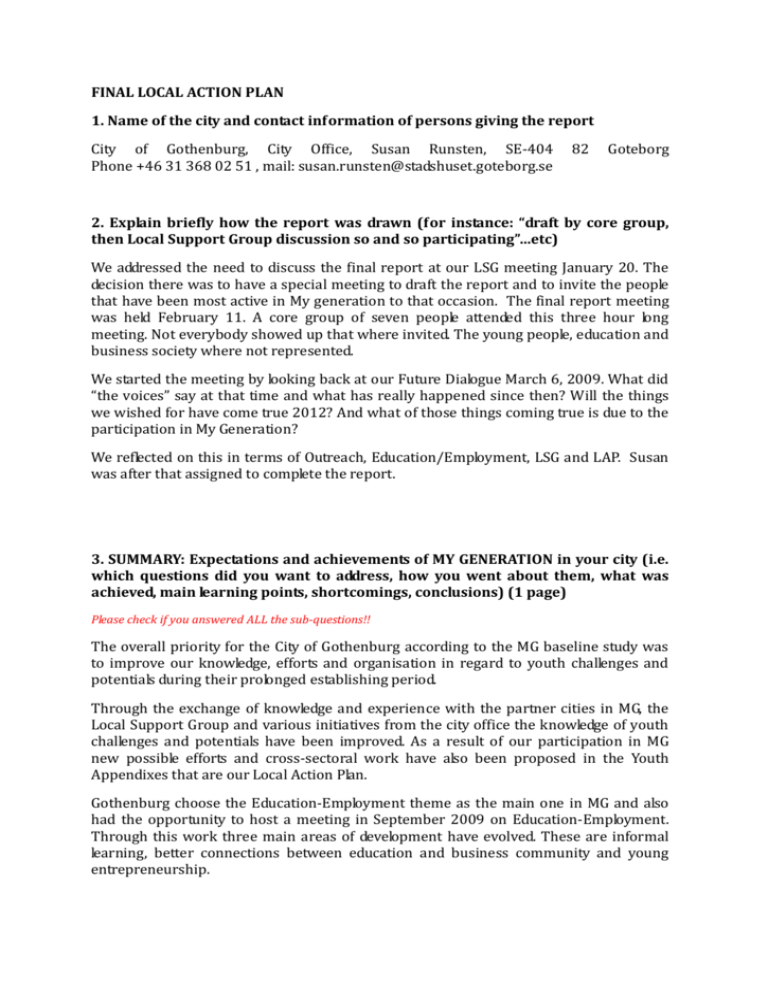
FINAL LOCAL ACTION PLAN 1. Name of the city and contact information of persons giving the report City of Gothenburg, City Office, Susan Runsten, SE-404 Phone +46 31 368 02 51 , mail: susan.runsten@stadshuset.goteborg.se 82 Goteborg 2. Explain briefly how the report was drawn (for instance: “draft by core group, then Local Support Group discussion so and so participating”…etc) We addressed the need to discuss the final report at our LSG meeting January 20. The decision there was to have a special meeting to draft the report and to invite the people that have been most active in My generation to that occasion. The final report meeting was held February 11. A core group of seven people attended this three hour long meeting. Not everybody showed up that where invited. The young people, education and business society where not represented. We started the meeting by looking back at our Future Dialogue March 6, 2009. What did “the voices” say at that time and what has really happened since then? Will the things we wished for have come true 2012? And what of those things coming true is due to the participation in My Generation? We reflected on this in terms of Outreach, Education/Employment, LSG and LAP. Susan was after that assigned to complete the report. 3. SUMMARY: Expectations and achievements of MY GENERATION in your city (i.e. which questions did you want to address, how you went about them, what was achieved, main learning points, shortcomings, conclusions) (1 page) Please check if you answered ALL the sub-questions!! The overall priority for the City of Gothenburg according to the MG baseline study was to improve our knowledge, efforts and organisation in regard to youth challenges and potentials during their prolonged establishing period. Through the exchange of knowledge and experience with the partner cities in MG, the Local Support Group and various initiatives from the city office the knowledge of youth challenges and potentials have been improved. As a result of our participation in MG new possible efforts and cross-sectoral work have also been proposed in the Youth Appendixes that are our Local Action Plan. Gothenburg choose the Education-Employment theme as the main one in MG and also had the opportunity to host a meeting in September 2009 on Education-Employment. Through this work three main areas of development have evolved. These are informal learning, better connections between education and business community and young entrepreneurship. West Swedens ESF managing authority has been active in MG. Parallel to this participation they also had a call for proposal specifically targeted at young people. The city of Gothenburg has many youth focused ESF projects running at the time. Quite a few of these project leaders have also been active in our LSG meetings. Being part of My Generation made it possible to compare ourselves with other cities. To see what we do good and what others do better. To be inspired by good practice and to disseminate our own good practice. To come up with new ideas for our local work and joint ideas on further collaboration. To be sometimes strengthened and other times questioned in our views and ways of doing things. The strongest message that came through to us was the one on co-creation. Another strong MG message is the one on finding better connections between different actors and sectors in order to promote the positive potential of the young generation. Being a partner in MG gave us a framework to start working with better coordination and a whole city perspective on youth issues in Gothenburg. We did this through our LSG but also through the work with our LAP. 4. TRANSFORMING OUTREACH: Work on transforming Outreach. Outreach might have been your main theme, or in a secondary role. In any case we need to know (1) What have you done in transforming Outreach, explaining also: (2) How have young themselves, the city & local, education & business community (possibly) been involved? (1-3 pages) Please check if you answered ALL the sub-questions!! Outreach has not been our main theme and it is a bit hard to put a finger on what it has really been about. Equally it is a bit hard to say what we have done in transforming outreach. At the Future Dialogue in March 2009 the local community voices spoke about the need to get focused on shared aims and cooperate to reach these aims for the youth work in the city. The voice emphasized the involvement of young people in this and the need to increase our understanding of young peoples needs. At the same time young people needed to deepen their knowledge of working life and employers needs. One way of doing this was through better cooperation between schools and business society. One clear message that came through in the future dialogue from the young voices was that the young people wanted to be taken more seriously and that their opinions should be valued higher. They wanted to be involved in the planning and decisions of activities targeted at themselves. They also perceived that adults were prejudiced towards young people and wished instead to develop a mutual dialogue between generations. At our LSG meeting in October 2009 the LSG members where divided into three working groups following the MG themes to work on the LAP. One group got the task to look at the Outreach-Youth Involvement theme. Another at Education-Employment. A third group worked with the Coordination and whole city perspective. Before the LSG meeting the city office had prepared a “map” for each theme with key words based on things already said and work already done so far in MG. For Outreach-Youth Involvement these key issues where: 1. 2. 3. 4. 5. 6. 7. 8. Both way dialogue Young role-models and leaders Participation, responsibility and trust Long term engagement, sustainability Combat prejudices Feeling safe and included Cross-over cooperation Possibility to influence The working group met several times and discussed these key issues, formulating goals, current status, obstacles, development potential and actions. The findings where presented at the next LSG meeting December 2009. In spring 2010 a case study on the Young & Safe Collaboration and Backa Base was produced. Gothenburg also participated with broad delegations at the Glasgow and the Gdansk meeting on Outreach. To be a part of the LSG and to participate in the Outreach meetings, especially the one in Glasgow, have helped to clarify how the local work needs to be developed in order to reach young people in the risk zone. The social service needs to use more untraditional methods, stepping out of the office, meeting young people where they are. Finding solutions that fit into their world. This realization was a good tool when things got out of hand (cars on fire etc) in the city ditrict of Backa for instance. As an example the social service at one point choose to use money they had to work with the young to employ 10 of the youngsters for six months instead of what they would have done traditionally. Transforming outreach has in this way been about exploring new ways of reaching out. To work with prevention and long-term efforts is much better than reacting to bad things when they have already happened. Sport clubs and other associations play an important role in this work. This we already new, but it has been good to be strengthened in this belief. Unfortunately, recent data shows that the social service tend to use more and more money to enforcement actions at the expense of prevention. For the Young and Safe Collaboration the meeting in Glasgow led to an invitation to Falkirk in Scotland where they got to present their work to the city. Some if the projects that the Young and Safe Collaboration have initiated 2009-2010 have been inspired by My generation outreach action. Following the meeting in Gdansk a collaboration between Riga and Gothenburg was also initiated focusing on youth participation and democracy. This is a project that will start in 2011 and involves young people visiting each other in these two cities. A youth association named My Generation was initiated by a group of young people active in My Generation 2010. One idea they had was to develop youth acitivites in Upp!s premises in evenings and on weekends. It has been a bit hard to get the association started. Especially since Helen, who had the task to support this initiative, left to do her PhD in London. The need to transform the work the city is doing to reach young people age16-20 that is not in school and not working has been identified by the city office. An investigated is currently being carried out. 5. EDUCATION AND EMPLOYMENT: Work on transforming Education and transition to Employment (“E/E”). E/E might have been your main theme, or in a secondary role. In any case we need to know (1) What have you done in transforming E/E, explaining also: (2) How have the young themselves, the city & local, education & business community (possibly) been involved? (1-3 pages) Please check if you answered ALL the sub-questions!! At the future dialogue the education voice spoke about the need to develop better cooperation between different professions and not work in a contra productive way. Individually based support and alternative roads to fulfill your education was emphasized. Företagarna, Ung Företagsamhet and Manpower gave voice to the business society. They spoke about the need to improve communication between the young and the employers, to fight discrimination and prejudice and to find new tools that help the young to get a foot into a working place. The need to develop a more creative and inclusive labour market that utilize young peoples potential, skills and ideas was also expressed. Since Gothenburg choose this theme as the main one in MG we also had the opportunity to host a meeting in September 2009 on Education-Employment. Preparing this seminar meant dealing with a lot of practical issues such as venues, food and transportation. However, it also helped us to highlight three main focus areas within our theme Education-Employment: Informal learning, Connections between education and business community and Young entrepreneurship. Preparing the study visits, city-guiding and workshop presentations resulted in new connections and involvement in My Generation of new actors in the Goteborg landscape. The case study on Education-Employment was initiated by our LSG in an attempt to get a better understanding of how informal learning is understood and worked with in the city. This was done with the aim to further visualize and develop informal learning in our future work. The discussions and documentation the case resulted in form a good platform for innovative action on documenting and evaluating informal knowledge. The results was presented at the September seminar 2009 in Gothenburg. The LSG working group that focused on the Education-Employment theme for the LAP had the following key issues to tackle: 1. Entrepreneurship , 2. Informal knowledge, 3. Validation 4. Education better adapted to the needs on the labour market, 5. Better connections between schools and business society 6. The potential in using young peoples engagement and desires as a driver 7. Alternation of generations 8. Internships with good quality The working group discussed goals, current status, obstacles, development potential and actions regarding these topics. Among other things this was pointed out: Drop outs should have more possibilities to upgrade their education Better coordination between different labour market interventions Individually based actions Everybody should have something to write in their CV turning 20 Gothenburg choose to involve the ESF managing authority in MG. During the MG period ESF Rådet did a call for proposal specifically targeted at young people. Gothenburg have many youth focused ESF projects running. Quite a few of these project leaders have also been participating in our LSG meetings. Navigator, Unga i Jobb and Upp! are examples of this. These project leaders have also done study visits to other MG cities to learn more about their good practice. Antwerpens C-stick, Rotterdams Youth Centers (Roger) and High Five have been popular. The fact that these ESF projects have been represented in our LSG led to greater awareness and new connections between different labour market interventions. It also led to new ideas on how to work together. For instance Manpower and Navigator had an idea on what they wanted develop together. One difference that has been pointed out by our ESF MA is that cities tend to have different approaches when formulating their projects. Rotterdam for instance start off with a good idea/innovation where as in Gothenburg the starting point is often the definition of a problem (rather than a solution). This makes a significant difference on what type of projects we run. Gothenburg also participated with a broad delegation in Valencia September 2010. Young people, ESF-projects, Social entrepreneurs, MA and the city office was represented. We found it especially inspiring with the entrepreneurship theme and to learn more about how Valencia and others worked with that. Gothenburg needs to develop the work on entrepreneurship on different levels if we are to foster new companies and job opportunities. Like for the Outreach theme, being active in the education-employment theme have also inspired us in different ways to take new actions and explore new ways to develop our work with youth unemployment, drop-outs and connections with business society. For example Upp! did something called Framtidskampen focusing on business society, CSR and getting good internships for a number of talented young people. Participating in MG has also been a way to highlight and disseminate Gothenburg projects in Europe. And to get European feed back on what we are doing. The fact that so many young people from Gothenburg have had the chance to go to the different MG meetings in Europe is also in itself an action on greater mobility and on getting experience that you can put in your CV. As for informal learning MG led us to identify this area as something we need to work more on. The ESF project Unga i Jobb currently work with this by exploring the method Open College Network (OCN). 6. LOCAL SUPPORT GROUP. Chapter on your Local Support Group activities (explain the composition, evolution and main activities of your LSG, and comment on how useful it has been, and what is the future of this networking. (1-2 pages) Please check if you answered ALL the sub-questions!! Gothenburgs Local Support Group had the following meetings: 2009: March 6, Framtidsdialog, location Teen Dream May 27, location Meeths salonger October 12, location City Office December 16, location Radar 72 2010: February 2, location Navigator Centre April 13, location Ung o Trygg October 7, location City Office 2011: January 20, location Upp! One final meeting is planned in May/June . Between the meeting in October 2009 and April 2010, three working groups had separate meetings to work with the LAP thematically. We also had a working group that prepared the Gothenburg seminar in September 2009. Civil servants from the city office (Susan, Lena, Jan, Helen) have been responsible for preparing and leading the LSG meetings and the various working groups as well as the documentation of it. Throughout the project it has been a core group of 10-15 people that participated in our LSG. It has further been about 15 people that participated more sporadically. We have kept it pretty open so that new participants could join when interested. Young people, local stakeholders, youth workers, project leaders, business society and education have been represented. A typical agenda for an LSG meeting have had the following topics: Host of the day intro, about the activities going on for young people in this place Feed back on a European workshop, study visit, conference etc that did take place since last meeting Discussing the focus of a case study, progress report or other MG tasks to be done Discussing the LAP Planning activities to come in MG European Youth Capital The fact that we had our meetings at different youth oriented working places turned out to be a good way to learn about each other in the city. New connections and ideas were created only by travelling around like this together. This exchange of knowledge and experience would not have happened without the MG framework and has been appreciated. In our LAP we explore ways of developing better coordination of the intersectoral youth issues. Having a group like the LSG could be part of the solution. Perhaps a bit more formalized (participants being pointed out by senior managers) and given a clearer mandate and task. 7. LOCAL ACTION PLAN and sustaining the best of MG. (Explain what your LAP is – The title, is it a part of a city strategy, a youth policy, for whom, what are the main points goals and responsibilities and next milestones, and comment on the usefulness of your LAP in sustaining the best of MG and establishing better coordination of youth activities and policies in your city) (1- 3 pages) Please check if you answered ALL the sub-questions!! The youth work in Gothenburg is decentralized and sector divided. This is evident in the political budget, in the way work with young people are organized locally and on the strategical level in the city office. When Gothenburg joined MG we had to put together a handful of civil servants at the city office in order to cover the whole youth policy area and the MG approach. Late 2008 this group had an idea to propose a youth theme in the follow-up process 2009. The follow-up process involves asking all our city ditricts, other administrations and companies how well they are achieving the political aims in the budget. This is done through quarterly reports. The youth theme was welcomed and a number of questions were formulated on youth involvement, cross-over cooperation and outreach in the follow-up reports. The results were summarized, analyzed and presented to the city executive board quarterly. During 2009 the pilot project KOMMUT was also conducted. KOMMUT was an attempt to develop new methods to follow up and analyze young peoples establishing period. Rich statistical material on certain age groups was used to analyze young peoples different life patterns and to identify key factors related to education, employment and community activities that could contribute to successful establishment. To sum up what had been reported in the youth theme in the four follow-up reports and to combine this with findings from KOMMUT, My Generation and current research the city office produced a Youth Appendix. This appendix was provided to all the political parties in the city executive board as an input to their budget work 2011. It had a disposition resembling the national youth policy, covering: 1. education and learning 2. work and self-support 3. health and vulnerability 4. influence and representation 5. culture and leisure activities 6. urban development In each section a description of what came out in the follow-up youth theme, findings in current studies, KOMMUT and My Generation was presented along with 4-5 points of development. The document also had a final chapter on the multisectoral dimension of youth issues and the need for better coordination on a city level. This Youth Appendix is the most comprehensive product that the city office has produced to support the politicians in developing a more active youth policy for the city. However since then we have had elections and new politicians are now responsible for the youth issues in the city executive board. In order to offer a repetition and at the same time do a closure on My Generation the city office are producing a shorter version of a Youth Appendix even this year as an input to the budget work 2012. This document will be finished this week and will focus on five development areas with suggested actions: 1. Youth policy in Gothenburg in relation to the national and European strategies 2. Youth involvement and influence – try new methods and create new forums 3. Young peoples equal value – the fact that Gothenburg is a segregated city and needs to work actively on young peoples equal possibilities 4. Inspiration My Generation – what we have learned through our participation in this network and how it could be implemented through Upp! and other on-going initiatives 5. European Youth Capital 2015 – a proposal to start working with ideas on content and budget for an application to become EYC 2015. Parallel to this second Youth Appendix a proposal has also been delivered to the management of the city office, pointing out the need to have a process management for youth issues at the city office. This is done in a time of a major reorganization of the office. Gothenburg considers the two Youth Appendixes put together to be our Local Action Plan. They include the best of MG with suggestions of how it could be used. They also express an ambition to establish better coordination of youth activities and policies in our city. 8. LEARNING IN MY GENERATION (Where did MG make a difference – what additional dimension did it add? What have been your main learning points in MG? Methods of Outreach, informal learning, youth engagement, connecting to business… what? Have you learned something important from other sources than MG that was useful? Where and what could you have learned more? (1-2 pages) Please check if you answered ALL the sub-questions!! My Generation is a network for exchange of knowledge and experience between European cities. When evaluating what difference MG have made and what additional dimension it added to Gothenburg, we find that this is exactly the contribution. It made it possible to compare ourself with other cities. To see what we do good and what others do better. To be inspired by good practice and to disseminate our own good practice. To come up with new ideas for our local work and joint ideas on further collaboration. To be sometimes strengthened and other times questioned in our views and ways of doing things. The strongest message that came through to us was the one on co-creation. Rotterdams B&W Next is a brilliant example of this. Another strong MG message is the one on finding better connections between different actors and sectors. This was already identified as important in our city, but by being a part of MG we were inspired to focus more on it. The City Office had specific questions about this in the follow-up process 2009. For the people that took part in the exchange, and the young people especially, it has given a sense of being part of something greater. It has been an experience that you could not get anywhere else and that could be used in other contexts as well. Being a partner in MG also gave us a framework to start working with better coordination and a whole city perspective on youth issues in Gothenburg. We did this through our LSG but also through the work with our LAP as described above. Ungdomsstyrelsen is the Swedish government agency for youth policy. They have published several reports 2009-2011 that our MG team found very interesting. The city office therefore invited them to Gothenburg on several occasions and arranged open seminars to learn more about the findings in their reports. These seminars have been popular. Because of these invitations Ungdomsstyrelsen also learned about My Generation and incorporated it as a good example of transnational activities in one of their reports. Bridging between MG and Upp! is a main Gothenburg strategy in implementing the good things that came out of MG and build further on the contacts and new connections it resulted in. See further our enclosed case study that describes this attempt. 9. REFLECTIONS ON THE MG-JOURNEY as a whole (i.e. has the “MG-journey” been useful for your city? Has the design, ways of working and support in MG been useful and adequate? How should these kinds of projects be improved in the future? (1-2 pages) Please check if you answered ALL the sub-questions!! The MG journey has been useful for our city. The participants have been affected in their way of looking at and working with youth issues. Participants have been inspired to try new approaches. Hopefully our MG ambassadors will create rings on the water in their work during the years to come. We have made new friends, progressed and earned new insights. We have been able to disseminate some of our local activities. It has been a good learning process within our city and between the partner cities. One of the MG strengths has been the focus on how to run seminars in a co-creative way, so that everybody feels engaged and included. It is however an act of balance to make the meetings youthful and fun and at the same time meaningful for professionals and MAs. Not in every case has this succeeded. The focus on form sometimes took over at the expense of content. At times the meetings could have been a bit tighter, more focused on the common challenges and possible solutions. Moore time could have been given to discuss common issues between the cities instead of talking to each other within our cities. The experts could have been given more opportunities/space to give the cities feed back on their on-going work. 10. OPEN COMMENT (perhaps you have something you want to add here as a free comment) The author of this report takes the opportunity to inform the MG leadership that she has got a new job as a project leader for an ERDF project called Urban development in northeast Gothenburg. She will leave the city office for this new assignment March 1. Unfortunately she will not be able to attend the final conference in Antwerp, but will never forget all the MG adventures and friends. Lena will close the project for our part. Good luck and thanks for everything! I am sure we will see each other again in just a slightly different context. Thank you!
